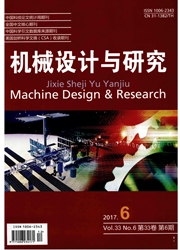

 中文摘要:
中文摘要:
摆线轮作为RV减速器的核心精密关键零件,其运行状况决定了减速器的传动精度、效率、疲劳寿命、可靠性等重要性能指标。如何确定摆线轮的最优齿廓修形参数是提高减速器传动精度、回差以及装配工艺性的关键技术。针对多种基于正等距加负移距的摆线轮齿廓修形模型,利用MATIAB工具分析各模型下的摆线针轮传动载荷分布、啮合齿对数、与转角修形共轭齿廓的趋近程度以及回转精度等特性。研究结果表明,各模型的优化参数存在一定差异,在接触齿对数、载荷分布等方面性能基本一致,修形齿廓与理论齿廓间的间隙大致相等,分布较为均匀,且修形齿廓均十分趋近转角修形共轭齿廓;基于齿廓法向间隙建立的模型既能保证同一时刻的多齿对啮合及承载的均匀性,又能得到更高的回转精度,更适合工程应用。
 英文摘要:
英文摘要:
As the core component of the RV reducer, the ~erformance of the cycloidal gear has critical influence on the transmission accuracy, efficiency, fatigue life and reliability of the reducer. And it is presumed to be the key techniques to improve the transmission accuracy, backlash and the assembly process by defining the optimum modifying parameters of the cycloidal gear. By analyzing the load distribution, the number of mesh tooth pair, the trend to the conjugate curve of slewing modification as well as rotary precision with MATLAB, a detailed comparison is carried out between different cycloidal tooth profile modification models based on positive equidistant plus negative radial-moving modification method. The results show that the optimization parameters of each model are different, while the number of mesh tooth pair and load distribution of each model tend to be the same ; the gap between the tooth profile of each model and theoretical profile is approximately equal and is distributed evenly. Besides, the profiles approach to the conjugate curve almost in the same level. The model based on the normal clearance of tooth profile has better meshing performance and higher transmission stability, which can make sure that several teeth mate simultaneously, the uniformity of load distribution and rotation accuracy, and is more suitable for engineering application.
 同期刊论文项目
同期刊论文项目
 同项目期刊论文
同项目期刊论文
 期刊信息
期刊信息
